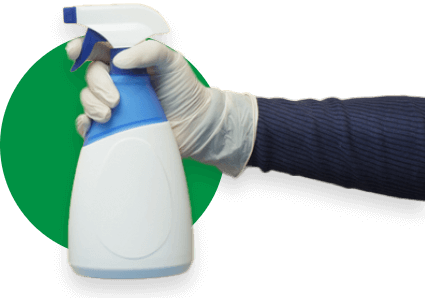With infections continuing to spread throughout the United States and the world, disease prevention protocols have never been more critical. Everyone can do their part to halt the spread of COVID-19 and other viruses by following CDC protocols for cleaning and disinfecting. Contrary to popular belief, cleaning is not the same as disinfecting, and both are necessary to protect ourselves and others from exposure to infection.
Most of us have probably used these terms interchangeably throughout our lives, but the distinction is very important. Let’s take a look at the key differences between cleaning and disinfecting, as well as how to implement both properly in the workplace.
The CDC definition of cleaning is as follows:
“Cleaning removes germs, dirt, and impurities from surfaces or objects. Cleaning works by using soap (or detergent) and water to physically remove germs from surfaces. This process does not necessarily kill germs, but by removing them, it lowers their numbers and the risk of spreading infection.”
Anytime you use soap, water and other detergents to clean dirt and debris from surfaces and objects, it’s considered cleaning. The important part of that definition is that it does not kill or destroy germs. It removes conditions that help them spread and grow, but it doesn’t get rid of them.
Effective Cleaning
To clean effectively and efficiently, any surface or object visibly soiled should be cleaned immediately. Use gloves and other personal protective equipment (PPE) to clean up spills, otherwise, you may create conditions that are favorable to germs and other microorganisms.
Moreover, it’s important to clean all frequently touched surfaces at work. Doors, doorknobs and handles, faucets, phones, keyboards, desks and any other equipment handled frequently should be cleaned at least daily.
Finally, be certain you are following the directions on your cleaning products correctly to get the most out of them. Improper use of cleaning chemicals, or using the wrong detergents for the wrong task, can be hazardous to your health. Worse still, it may leave behind dirt, grime and germs that would otherwise be washed away with the correct product.
Defining Disinfecting
The key to understanding disinfecting lies in its CDC definition:
“Disinfecting kills germs on surfaces or objects. Disinfecting works by using chemicals to kill germs on surfaces or objects. This process does not necessarily clean dirty surfaces or remove germs, but by killing germs on a surface after cleaning, it can further lower the risk of spreading infection.”
Notice the difference? Cleaning is removing dirt, grime and germs that have accumulated on a surface to get them off. It’s a more passive form of germ control. Disinfection, conversely, is an active measure to kill and eliminate germs.
It’s not about getting the dirt off; it’s making sure any germs, viruses, or bacteria living on a clean or soiled surface are killed off as completely as possible. A thorough cleaning followed by proper disinfection is the most effective way to prevent the spread of germs and disease.
Effective Disinfecting
EPA-registered disinfectants should be used after a thorough cleaning to remove any visible dirt or other accumulations. There are different types of disinfectant rated for killing specific types of germs and viruses, so checking the label to make sure you have the correct disinfectant is imperative.
Additionally, most disinfectants need time to function properly and must be left on surfaces for set time periods outlined in their instructions. This is referred to as dwell time and refers to the amount of time a disinfectant remains wet on a surface to effectively kill germs. Even if surfaces are kept clean, they need to be disinfected regularly to prevent the spread of disease.
Frequently touched electronics like phones, tablets, computers and keyboards/mice should be treated with disinfectant wipes. Check the instructions regarding dwell time for your wipes, too. It may take more than one wipe for certain surfaces or objects. The air quality conditions where the device is kept are also a factor. Finally, make sure you unplug, disconnect or power off any electronics that need disinfection but can’t be exposed to liquid while powered up. Nobody wants to replace expensive equipment in the name of sanitation.
How To Clean and Disinfect for COVID-19
COVID-19 is a novel coronavirus that requires specific protocols to eliminate it safely. You need the correct type of cleaning agents and disinfectants to ensure that you are eliminating its potential presence from all high touch surfaces and high exposure areas of your workspace. More importantly, the correct process is essential to keeping everything clean and disinfected. Here are the two most experts recommend:
One-Step Process
Cleaning and disinfecting happen simultaneously with a one-step process. Combination cleaner/disinfectants are the “weapon of choice” for a one-step process, and it can be effective in environments where surfaces are already cleaned regularly.
When choosing a combination cleaner/disinfectant for a one-step process, check the label for dwell time and what organism it can effectively kill. One-step cleaning is not the preferred method for professionals, but it is far better than not disinfecting after cleaning at all.
The actual process is simple: spray cleaner/disinfectant on the surfaces that need cleaning, allow it to dwell, and then wipe everything down with an appropriate disposable cleaning wipe. Now that we’ve covered the one-step process, let’s talk about what a two-step process looks like.
Two-Step Process
The preferred methods for cleaning and disinfecting, the two-step process, involves using two separate products to achieve more sanitary conditions in your workplace. Step one is applying a cleaning agent to remove the visible and loose soils from surfaces and objects. Use a microfiber cloth to clean each surface thoroughly. It’s a good idea to keep different color cloth for each type of surface, so you don’t cross-contaminate surfaces. For example, you wouldn’t want to use a cleaning cloth from the bathroom in the kitchenette or break room area.
Step-two involves spraying down surfaces with disinfectant and allowing it to sit for the dwell time recommended on the bottle. Keep an eye on it, so it stays wet the entire duration of its dwell time. Failing to follow the recommended dwell time on the label can cause germs or other microorganisms to linger on high touch surfaces.
Naturally, this eliminates the purpose of disinfecting surfaces, so dwell time is a critical component of the two-step process. Provided you follow the manufacturer’s recommendations and directions on all labels, you should find that the two-step process helps you effectively reduce infection risks and maintain a higher standard of sanitation in your workplace.
Cleaning Waste Disposal
Wear gloves and other appropriate PPE when cleaning and handling used cleaning products like towels and cleaning cloths. Put all disposable cleaning items in the trash as soon as you finish using them. Additionally, wash your hands with warm soapy water as soon as you have finished disposing of cleaning waste or emptying trash cans.
Final Thoughts
Cleaning and disinfecting are both an important component of combating COVID-19. That being said, each facility or workplace has a unique cleaning and disinfection needs. Every business needs different cleaning products, and some businesses need higher frequency cleaning of high traffic areas.
Maybe you already have a cleaning service, but do you know if they have established two-step processes with the correct disinfectant for COVID-19? Do they practice proper waste disposal? If your business is local to the Dallas/Fort Worth area, consider Dallas Janitorial Services. Our highly trained professionals are ready to keep your office or business clean and sanitary even with the ongoing COVID-19 crisis. Call or visit our website today to set up a consultation.







